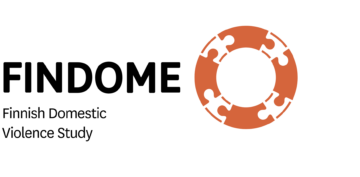
What is domestic violence?
Domestic violence (DV) means physical, mental or sexual violence within an intimate relationship or a family. At least 1 in 3 report experiencing DV during their adult life. In addition to acute injuries, DV leads to various adverse health outcomes like functional disorders, mental-health problems, disability and even death. Victims of DV use more health care services than average and they are especially over-represented in emergency care for both injuries and somatic and psychiatric conditions. Still, DV often goes unnoted in health care even when the patient is seeking help for DV related injuries. World Bank has estimated the overall yearly costs of IPV to be around 1,2 to 2% of GDP, meaning yearly costs of 2000-4000 million euros in Finland. So far, little is known about secondary prevention of DV and evidence is lacking on how to efficiently reduced the negative effect of DV on health.
As the first part of the FINDOME, we collaborated with the world-renown Center for Evidence-Based Orthopaedics at McMaster University by participating in PRAISE-2, the extension of the prestigious PRAISE (Prospective Abuse and Intimate Partner Violence Surgical Evaluation Study) project.
What is PRAISE-2?
PRAISE-2 was a pilot prospective cohort study of 250 women with fractures. The study aimed to determine the feasibility of a large multinational cohort study to examine surgical outcomes among those injured women who report, or do not report, a history of abuse. PRAISE-2 was the first study to evaluate differences in orthopaedic outcomes between abused and non-abused women and preliminarily assess whether an injury can lead to worsening abuse by an intimate partner. We recruited 24 female patients for the study at the Department of Orthopaedics and Traumatology of Helsinki University Hospital.
In the first interview of the PRAISE-2 cohort study, 30% of the 250 study patients reported experiencing violence by their intimate partner. During the follow-up interviews within the 12-month study period, further 8% of the study patients disclosed experiencing of intimate partner violence. The results of the PRAISE-2 pilot study also indicated that ongoing and past experiences of intimate partner violence may associate with lower health-related quality of life during recovery from an orthopaedic injury. However, in this small pilot sample there was no evidence of higher rates of injury complications or severe adverse adverse events among the patients with a history of intimate partner violence.
What are the next steps in FINDOME project?
FINDOME is about developing evidence-based tools for secondary prevention of DV. We are currently working on DOME-IDENFTIFY and DOME-EDUCATE studies.
DOME-IDENTIFY explores how often health care professionals identify victims of DV in an emergency department setting. We are interested to see if staff education and implementation of new protocol for care of DV victims will rise the rates of DV identification. We are developing an AI -based Natural Language Processing algorithm to ensure high quality in data collection.
DOME-EDUCATE gathers information on the knowledge and perceptions of various professionals who encounter and assist DV victims as a part of their daily practice. We will explore new approaches on fostering collaboration between all professionals involved in the secondary prevention of DV to efficiently diminish the negative health effects of DV. As a part of FINDOME project, we are also developing digital learning material for these professionals to improve their skills in recognizing and helping the DV victims.
Where are we now?
So far, we have published:
The editorial of the Duodecim medical journal


